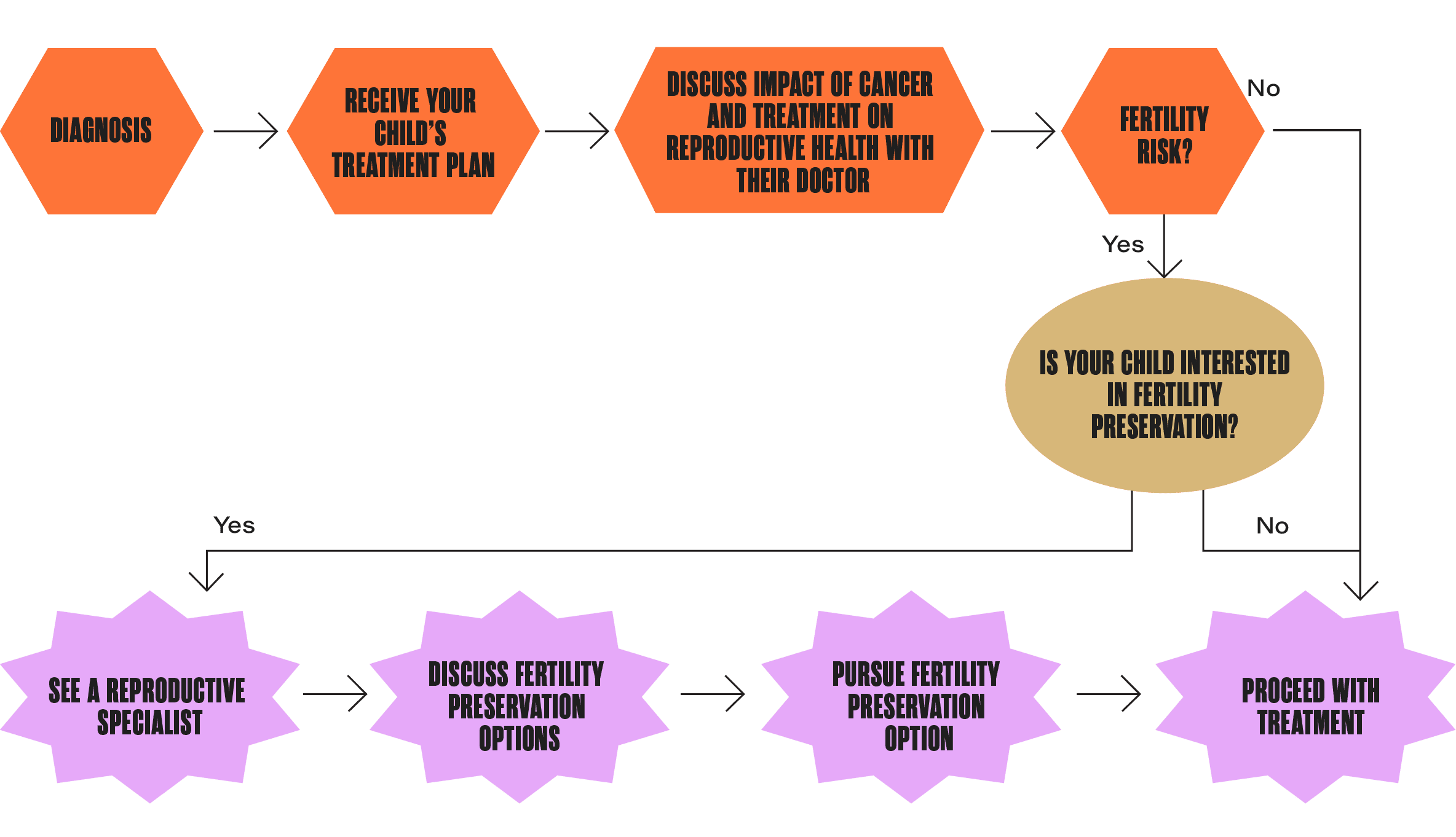Parents
Fertility might be the last thing on your mind when your child is diagnosed with cancer. But taking some time to think through your kid’s fertility now will give them options later if and when they’re ready to build their own family.


Your Child’s Oncofertility
Fertility might be the last thing on your mind when your child is diagnosed with cancer. It’s understandable to be solely focused on their cancer treatment, immediate health, and overall wellbeing. But taking some time to think through your kid’s fertility now will give them options later if and when they’re ready to build their own family.
Some cancer treatments, such as chemotherapy, radiation, and surgery, can impact your child’s reproductive health and make it harder for them to have children in the future. Girls are born with all the eggs they will ever produce in their life, but unfortunately some treatments can damage those eggs. Boys don’t start producing mature sperm until they go through puberty, but some cancer treatments can impact your son’s ability to have kids whether they’ve gone through puberty or not. However, there are options to help you protect your child’s fertility if they want biological children in the future.
The Talk
Having an age appropriate conversation with your kid about their future family can help you decide what option is best for them. Try having an open conversation with your child and their doctor about what fertility is and why they might want to preserve it. And don’t forget to discuss your child’s options for growing a family if they opt out of fertility preservation, such as adoption or egg/sperm donors. Consider involving a child life specialist in these discussions to help you explain everything to your child using age appropriate language.
Depending on your child’s age and your relationship, it might be easier for another trusted adult like an aunt or uncle, close family friend, or their doctor to take the lead on this conversation. Consider asking your kid if they’d rather talk to someone else about this topic besides you. The most important thing is that they’re having the conversation with someone they trust and are given their options.
Talking to your child
- Do you think you want to have kids when you’re older? Do you want to be a mom or a dad one day? Or do you want to have the option to decide later?
- Have you thought about if you want biological children? Or would you be interested in adopting or using donor sperm/eggs to have a baby?
- Do you understand how your cancer treatment could impact your ability to have a baby when you’re older?
- How do you feel about preserving your fertility? Does it feel like too much on top of your cancer treatment?
Talking to their doctor
- Will my child’s cancer or cancer treatment affect their fertility? Are there options that are less detrimental to their reproductive health?
- What are the options to try to preserve my child’s fertility before they begin cancer treatment?
- Can you refer us to a fertility preservation specialist to discuss my child’s options further?
- Does my child have time to pursue fertility preservation?


Your Child’s Fertility Treatment Path
If you have decided to preserve your child’s fertility, it’s important to act quickly to give them the best chances at success. Understanding where fertility preservation fits in their cancer diagnosis and treatment plan will help you advocate for your child.
If your kid has already started or completed treatment for cancer, but didn’t preserve their fertility beforehand, they’re not necessarily out of luck. Speak with a reproductive specialist to understand their ongoing fertility options.

Your Child’s Options
Your child has options when it comes to preserving their fertility, but they might be dictated by their diagnosis, age, overall health, or other factors that can impact reproductive health. A reproductive specialist can help your family identify your child’s best option.

Options for Girls
(and anyone assigned female at birth)
Fertility Options Before Treatment
![]()

Ovarian Tissue Freezing
Removing ovarian tissue
This is a procedure that removes the entire ovary, or pieces of an ovary, during surgery. The removed tissue will then be divided into small pieces and frozen. The outer layer of the ovary, which holds the eggs, will be stored for future fertilization. If and when your child is ready to have a kid of their own, the tissue will be thawed and re-implanted in their body, with the hope that eggs in the tissue will mature and release naturally with ovulation, allowing them to become pregnant.
![]()

Egg Retrieval
Removing eggs from the ovaries
This procedure uses a vaginal ultrasound to guide a thin needle through the vagina and into the ovary to retrieve eggs. Prior to the egg retrieval, your child may need to take fertility drugs to stimulate the development of multiple eggs in order to have as many viable eggs as possible.


Egg Freezing
Storing eggs
After an egg retrieval, you can store your child’s unfertilized eggs. The eggs are frozen for storing so they can be used in the future. When your child is ready to use them, the eggs will be thawed, combined with sperm to create embryos, and transferred to their uterus. If the embryo successfully implants in the uterus, they will have become pregnant.
Fertility Options During Treatment
![]()

Ovarian Transposition
Moving the ovaries to avoid radiation
If your child is receiving radiation therapy to the pelvis, this surgery will move their ovaries away from their normal location to lower the amount of radiation they’re exposed to. This may help the ovaries keep working normally during and after treatment.
![]()

Radiation Shielding
Protecting the ovaries from radiation
A shield is placed around the ovaries to protect them from the harmful effects of radiation.

Options for Boys
(and anyone assigned male at birth)
Fertility Options Before Treatment
Testicular Tissue Freezing
Removing testicular tissue
Since children aren’t yet producing sperm, this option takes a tissue sample from their testicles and freezes it until it is ready to be used, at which point it is thawed and sperm is removed from the tissue. This is an experimental procedure.
![]()

Sperm Banking
Storing your child’s semen
This well known option collects and stores a child’s healthy semen before they undergo cancer treatment. The sample can be collected via masturbation, mechanical, or electro-ejaculation. It’s also called sperm cryopreservation or semen storage.
Fertility Options During Treatment
![]()

Testicular Shielding
Protecting the testes from radiation
A shield is placed around the testes to protect them from the harmful effects of radiation.
Learn more about insurance, financing, and your family’s rights when it comes to fertility preservation.
Opting Out
Whether you don’t want to put your child through more procedures, they don’t want to have their own kids in the future, or you just didn’t know about fertility preservation before they started treatment, it’s okay to opt out.
If your child wants to grow their family in the future, they still have options. When they are ready, your child should meet with a reproductive specialist to undergo fertility testing to understand how much their treatment impacted their fertility. If they’re unable to have biological children, they still have other options including adoption, surrogacy, foster to adopt, and embryo adoption.


Quarterbacking your care
Our CareLine provides personalized cancer navigators for people with cancer and their caregivers. Your navigator can help you:
- Get financial & insurance help
- Learn about employment protections
- Apply for social services
- Get mental health support
- Understand fertility options





